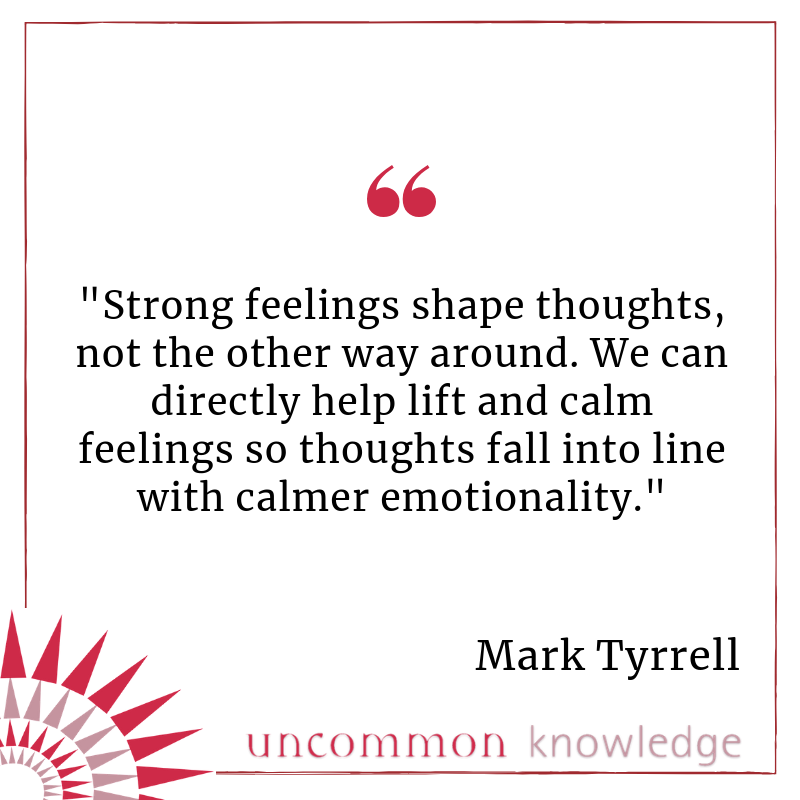
“The mind is its own place, and in itself can make a heaven of hell, a hell of heaven.” ― John Milton, Paradise Lost
“Very little is needed to make a happy life; it is all within yourself, in your way of thinking.”
—Marcus Aurelius, Roman Emperor and ancient inspiration for Cognitive Behavioural Therapy (CBT)
I’m a huge admirer of Aurelius and love his ‘Reflections’, but in the interests of thinking for myself, I open with the above quote from the famous stoic because in my humble opinion it is just plain wrong. Or at the very least, vastly incomplete.
Let me explain.
Prefer to watch instead?
People thrive in environments that help them meet their innate needs. The insightful video below clearly shows how a need-meeting environment protects against chemical addiction and aids happiness and fulfilment. As human beings, we have innate needs, and we have an instinctual desire to fulfil them. And when we don’t, we unavoidably suffer.
I think it’s reassuring to let clients know that their happiness isn’t just about what they do inside their minds. It’s also about taking action to identify and meet their needs. People who meet their needs in a balanced way are less likely to suffer anxiety.
Just as thirst is a signal that you’re not meeting your need for hydration, anxiety is a signal that you’re not meeting your needs. Now, this isn’t to say that what we do with our minds has no relevance to our happiness or lack thereof. Of course it does. The way we feel is not just a response to the way things really are out there in the world, it’s also about how we make sense of that.
In case you thought I was done ranting, I have one other issue with CBT that I need to air before I give you three easy-to-apply CBT techniques for treating anxiety that I have found useful.
The shaky theory of changing thoughts to change feelings
Strong emotion arises not after thoughts but before them (1). So it is often easier and more powerful to change feelings than it is to change thoughts. Again, this basic neuroscience contradicts classical CBT. Emotions are a fundamental human characteristic, essential for immediate physical survival. They are more powerful than thoughts, occur more quickly than cognition and sometimes with no associated thoughts.
Clinical hypnosis is the best way to change feelings (2), and a change in our thoughts is a natural consequence of a change in our emotional responses. For Post-Traumatic Stress Disorder and phobias it’s not faulty thinking that is the problem, and the chances of making significant progress through CBT are remote.
But I’m not completely condemning CBT here! I do believe it can be useful for less severe anxiety conditions – but only when used with skilled approaches that work directly to calm feelings.
Here are three simple techniques that focus on the thinking and behaving part of a person to help them take back control.
CBT technique 1: Focus on how the feelings will change
I often remind clients that feelings are fluid and inevitably change. So even if, after all the relaxed mental rehearsal work we’ve done, they find themselves starting to feel a little anxious, I want them to be thinking about what their feelings will be once they’ve started to feel better again.
It might help to write down those expected changes in a few words. So if they are nervous about a presentation, they might write down something like:
“I am feeling somewhat nervous, which is natural. When those feelings change I expect to feel calm and clear headed again.”
On top of this I will ask them to imagine what the very first little sign might be that those alterations in feelings are starting to happen. They might tell me that they will find themselves speaking more spontaneously to their audience. It might be helpful to write this down too.
Feelings always shift, and even just remembering that is useful. Having your client write or think about how they expect their feelings to improve and the first little indications that anxiety is morphing into calm take that concept to the next level.
All good psychological interventions help change expectations, and this technique is no exception. The next technique can be applied in lots of ways and is more behavioural than cognitive.
CBT technique 2: Chew it over and act normal
Anxiety is a survival response, not an illness. But it’s a response that can go wrong, sometimes to the point that it hinders rather than helps. Like a guard dog that feels like it’s helping even as it bites the leg of the friendly mailman, your anxiety response kicks in because it senses a threat, even though that perceived threat may not actually be real. One way to train anxiety to be selective and ‘behave’ is to give it feedback to let it know: “Thanks, but you’re not needed right now.”
Because anxiety takes its lead from what clients do, as well as simple emotional pattern matching, then if the client acts in ways they wouldn’t in a real emergency, the anxiety will fade away. For example, during an emergency we wouldn’t:
- Talk softly and calmly
- Smile
- Salivate
- Breathe deeply
- Have an open body posture.
If we adopt some of these behaviours, even just one of these behaviours, when we begin to feel stressed, then we alter the feedback to our fear response system (our sympathetic nervous system). We send it a message: “See, if there was a real threat I wouldn’t be salivating, talking normally, breathing out for longer than I breathe in.”
Something even the most anxious client can easily do is chew gum (or even just imagine they are). This is something you would never be doing during a genuine threat, producing saliva in anticipation of eating.
We don’t tend to have the luxury of eating in life-threatening circumstances. So we can encourage our clients to ‘act normal’ during stressful times to quickly change the feedback loop and switch off anxiety fast. And just knowing they can do this can give them a huge boost in confidence.
Anxiety is all about expectation – which tends to be catastrophic! So let’s bring some thought to it next.
CBT technique 3: Catch the underlying assumption and chase down logical conclusions
If someone feels anxious about something, it’s because they have a fear of some consequence. But what is that consequence?
If I fear attending a party I might ask myself, “What consequence do I fear?”
I might decide, “I fear meeting new people.”
But what is the consequence of that? “They might not like me!”
But what is the consequence of that? “I will feel upset.”
But what is the consequence of that? “I will feel that I am unlikable!”
And so on. Then we can go on to, “But how will I deal with that?”
“I will remember people who do like me.”
“I will soon forget about the party.”
“I will remember that I can be wrong when assuming people don’t like me.”
I have done this with people who are insecure in relationships by having them describe what it is they fear and begin to see that the relationship breakdown wouldn’t be some kind of catastrophic end but a step along the path to something else that wouldn’t necessarily be bad.
When someone comes to feel that even if the relationship did end they would and could survive, even thrive, then the fuel for the insecurity dries up.
So the takeaways here are:
- Strong feelings shape thoughts, not the other way around (although Marcus Aurelius did have some great insights). We can directly help lift and calm feelings so thoughts fall into line with calmer emotionality.
- Working to reframe thoughts can be really useful.
- We can help people remember that feelings always change and focus on how they expect any current unpleasant feelings to change. This alone can begin to bring about the very expectation they have imagined.
- We can teach clients to alter their behavioural feedback so as to send the message to their sympathetic nervous system: “Nothing to report here, no emergency, stand down!” And just knowing this is possible can help clients feel more secure and confident.
- Finally, we can enable clients to catch underlying assumptions and follow logical conclusions to think about how they would actually survive – even thrive – if the ‘worst’ did happen.
Marcus Aurelius also said:
“We ought to do good to others as simply as a horse runs, or a bee makes honey, or a vine bears grapes season after season without thinking of the grapes it has borne”.
And we can’t say fairer than that.
Related: Top 10 CBT Worksheets Websites
Notes:
- Nadler, Relly. “What was I thinking.” Handling the hijack. Business Management 16 (2009). PDF available here
- P. Rainville, R. K. Hofbauer, M. C. Bushnell, G. H. Duncan and D. D. Price, “Hypnosis Modulates Activity in Brain Structures Involved in the Regulation of Consciousness,” in Journal of Cognitive Neuroscience, vol. 14, no. 6, pp. 887-901, 15 Aug. 2002, doi: 10.1162/089892902760191117.











